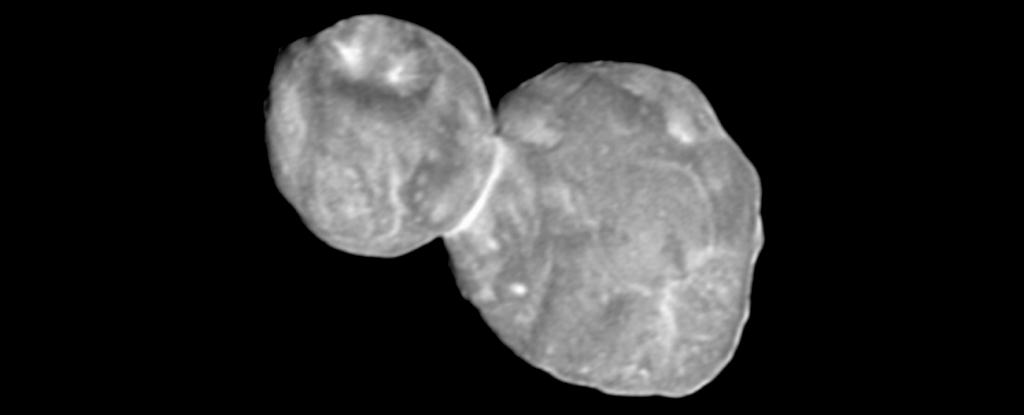In the far reaches of the Solar System, a small rock is showing us how giant planets get their start. Arrokoth - the most distant and most primordial world ever visited by a human spacecraft - now spills its secrets in three new papers.
Those findings could resolve some debate about how planetesimals - the small rocky 'seeds' that grow into planets - are formed. And the process appears to be a lot more gentle than previously thought.
"Arrokoth is the most distant, most primitive and most pristine object ever explored by spacecraft, so we knew it would have a unique story to tell," said Alan Stern from the Southwest Research Institute in Colorado and New Horizons Principal Investigator.
"It's teaching us how planetesimals formed, and we believe the result marks a significant advance in understanding overall planetesimal and planet formation."
Arrokoth, formerly known as (486958) 2014 MU69 or Ultima Thule, was visited by the New Horizons probe on New Year's Day last year, way out in the Kuiper Belt.
At a staggering average distance from the Sun of 6.7 billion kilometres (4.1 billion miles), and an orbital period of 293 years, Arrokoth is the most distant single object in the Solar System we've identified.
But sending New Horizons to check it out after the historic Pluto flyby in July 2015 wasn't done just because we could. That far from the Sun, out of reach of harsh solar radiation, and with a stable orbit, Arrokoth is pretty much a time capsule from the time when the Solar System formed, 4.6 billion years ago.
"There is no evidence," the team wrote in their paper, "of heliocentric, high-speed collisional evolution, or any catastrophic (or sub-catastrophic) impact during its lifetime… Instead, we conclude that its two lobes came together at low velocity, no more than a few metres per second and possibly much more slowly."
That suggests that the two lobes formed in the same part of the solar nebula - the cloud of gas and dust that formed the Sun and planets.
"Arrokoth looks the way it does not because it formed through violent collisions, but in more of an intricate dance, in which its component objects slowly orbited each other before coming together," said McKinnon.

https://www.sciencealert.com/here-s-what-arrokoth-can-tell-us-about-how-baby-planets-are-born
Those findings could resolve some debate about how planetesimals - the small rocky 'seeds' that grow into planets - are formed. And the process appears to be a lot more gentle than previously thought.
"Arrokoth is the most distant, most primitive and most pristine object ever explored by spacecraft, so we knew it would have a unique story to tell," said Alan Stern from the Southwest Research Institute in Colorado and New Horizons Principal Investigator.
"It's teaching us how planetesimals formed, and we believe the result marks a significant advance in understanding overall planetesimal and planet formation."
Arrokoth, formerly known as (486958) 2014 MU69 or Ultima Thule, was visited by the New Horizons probe on New Year's Day last year, way out in the Kuiper Belt.
At a staggering average distance from the Sun of 6.7 billion kilometres (4.1 billion miles), and an orbital period of 293 years, Arrokoth is the most distant single object in the Solar System we've identified.
But sending New Horizons to check it out after the historic Pluto flyby in July 2015 wasn't done just because we could. That far from the Sun, out of reach of harsh solar radiation, and with a stable orbit, Arrokoth is pretty much a time capsule from the time when the Solar System formed, 4.6 billion years ago.
"There is no evidence," the team wrote in their paper, "of heliocentric, high-speed collisional evolution, or any catastrophic (or sub-catastrophic) impact during its lifetime… Instead, we conclude that its two lobes came together at low velocity, no more than a few metres per second and possibly much more slowly."
That suggests that the two lobes formed in the same part of the solar nebula - the cloud of gas and dust that formed the Sun and planets.
"Arrokoth looks the way it does not because it formed through violent collisions, but in more of an intricate dance, in which its component objects slowly orbited each other before coming together," said McKinnon.

https://www.sciencealert.com/here-s-what-arrokoth-can-tell-us-about-how-baby-planets-are-born

